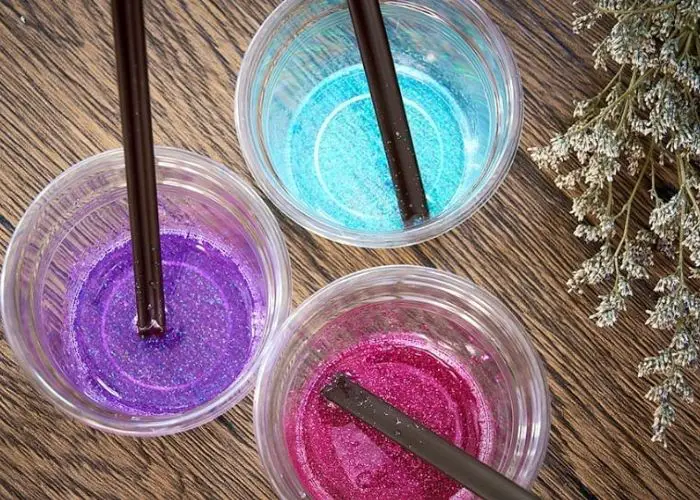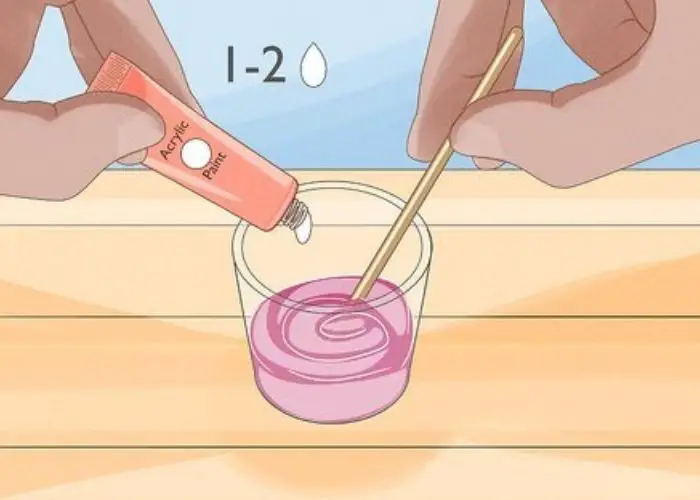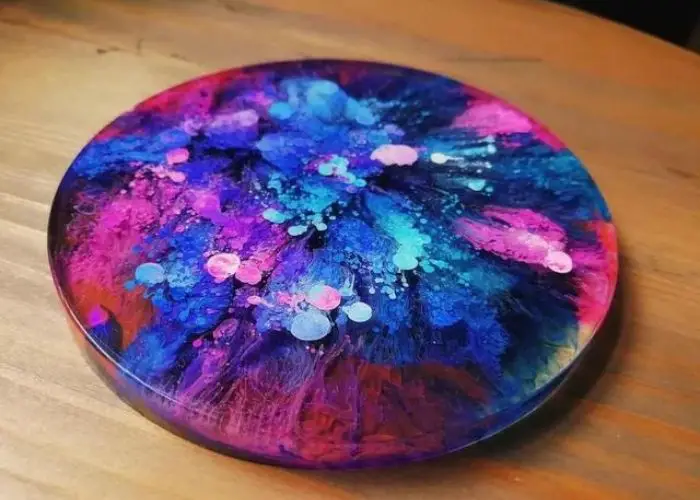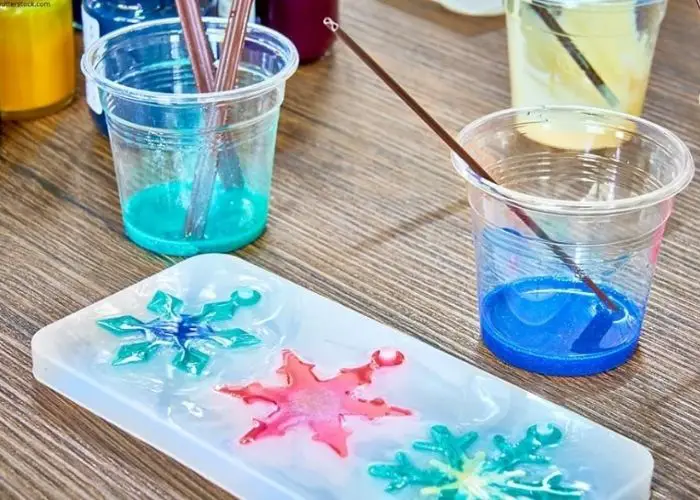When it comes to painting, there are a variety of mediums that can be used.
Some artists prefer to stick with one type of paint, while others enjoy mixing different types together.
Can you mix acrylic paint with resin? This is a question that many people ask, and the answer is yes – you can mix acrylic paint with resin.
However, there are some things you need to know before you do so. This blog post will discuss what epoxy resin is and what it is used for.
We will also discuss what acrylic paint is and its use. Then, we will talk about the pros and cons of mixing acrylic paint with resin.
Finally, we will give you some tips on coloring epoxy resin with acrylic paint.
Can You Mix Acrylic Paint with Resin?
Some people believe that it’s the only way to get the true colors of the paint, while others think it makes the paint too thick and difficult to work with. In general, it is possible to mix the two together, but it’s important to experiment with different ratios to find the right combination for your project.
What is Epoxy Resin?

Epoxy resin is a type of plastic that is often used in crafting and repairs. It comprises two parts, the epoxy resin, and the hardener.
When these two parts are mixed together, they create a strong bond that can be used to fix or create different objects. Epoxy resins are available in both clear and opaque colors.
What is epoxy resin used for?
Epoxy resin can be used for a variety of different projects.
- It is often used to create jewelry, as it can be poured into molds and shaped into different designs.
- It can also be used to repair wood or metal objects.
- Epoxy resin is also popular in the world of art, as it can be used to create sculptures and paintings.
What is Acrylic Paint?
Acrylic paint is a type of synthetic paint that was first created in the 1940s. It is made up of pigments that are suspended in a polymer emulsion.
Acrylic paint dries quickly and can be thinned with water. It is available in a variety of different colors.
What is acrylic paint used for?
Acrylic paint as well can be used for different projects.
- It is often used by artists who want to create bright-colored paintings.
- Acrylic paint can also be used to add color to resin projects.
- They are also used in decorative painting techniques on canvas, metal, plastic, and other surfaces.
Learn more here about using acrylic paint on plastic.
Mixing Paint with Epoxy Resin
When it comes to mixing paint with epoxy resin, there are a few things you need to keep in mind.
First, you need to ensure that the ratio of paint to resin is correct. Too much paint can make the resin too thick and difficult to work with.
For best results, it is important to follow the ratio of 1 to 10 rule when using liquid acrylics.
Second, you need to mix the two together thoroughly in order to avoid any streaks or clumps in your project.
Finally, you need to be aware of the fact that the paint will change color when it is mixed with resin.
This is due to the fact that the pigments in the paint will react with the chemicals in the resin.
Can You Put Acrylic Paint in Resin?
You can mix acrylic paint with resin, but you need to be careful about the proportions.
Resin is a clear or translucent material that is often used as a protective coating for surfaces. It is also used as an adhesive or filler in some products.
Acrylic paint is a type of paint made with pigment suspended in acrylic polymer emulsion.
When mixed together, the two substances can create a variety of effects. For example, you can use them to create a marbled effect or to add texture to a painting.
However, it is important to note that acrylic paint will eventually fade when exposed to light.
Therefore, if you plan to use this technique for a long-term project, you may want to consider using UV-resistant resin.
How to Color Resin with Acrylic Paint

There are a few different ways that you can color resin with acrylic paint. One way is to mix the two together until you achieve the desired color.
Another way is to add paint drops to the resin and then stir it until the color is evenly distributed.
You can also use a toothpick or other sharp object to add streaks of color to the resin.
Finally, you can pour different paint colors into the resin and then swirl them together to create a marbled effect.
Here’s a step by step process of coloring epoxy resin with acrylic paint:
Materials and tools needed
- Gloves
- Goggles
- Epoxy resin
- Acrylic paint
- Hardener
- Bowl
- Digital scale
- Pigment powder
- Toothpick/sharp object
Coloring epoxy resin with acrylic paint step by step
Step 1: Put on gloves and goggles to protect yourself from toxic fumes:
Before you begin, it is important to put on gloves and goggles. This will protect you from the toxic fumes that can be released when you mix resin and paint together.
Step 2: Mix the resin with a hardening agent
In a large bowl, mix together the resin and hardening agent. Make sure that you follow the instructions on the package in order to get the correct ratio of resin to hardener.
The best hardening agent is one that contains a UV inhibitor. This will help to prevent the resin from yellowing over time.
Step 3: Weigh out the amount of resin you want to color with a digital scale
Using a digital scale, weigh out the amount of resin you want to color. In general, you will need about two ounces of resin for every one ounce of paint.
Step four: Add the pigment powder to the resin
Add the pigment powder to the bowl and mix it in thoroughly. You can use a variety of different colors or just stick to one.
Step five: Add the resin to your mold
Once you have mixed the pigment powder into the resin, you can pour it into your mold.
Make sure that you do this slowly to escape the air bubbles. You can then use a toothpick or other sharp object for popping any remaining bubbles.
Step six: Stir the mixture until it is a uniform color
Stir the mixture until it is a uniform color. You can then pour it into your mold and let it harden.
Step seven: Allow the resin to cure
Allow the resin to cure for at least 24 hours before removing it from the mold. If you are using a UV-resistant resin, you can expose it to sunlight or artificial light to speed up the curing process. And there you have a durable finish.
Disadvantages Of Mixing Acrylic Paint in Epoxy Resin
There are a few disadvantages of mixing acrylic paint in epoxy resin.
- One disadvantage is that the paint can eventually fade when exposed to light.
- Another disadvantage is that the paint can become brittle and crack over time.
- Finally, the paint can also affect the clarity of the resin. If you are planning on using this technique for a long-term project, you may want to consider using UV-resistant resin.
Tips for Adding Acrylic Paint to Resin
You can do a few things to ensure that your acrylic paint and resin mix together properly.
First, make sure that you use a hardening agent that contains a UV inhibitor. This will help to prevent the resin from yellowing over time.
Second, weigh out the amount of resin you want to color with a digital scale. In general, you will need about two ounces of resin for every one ounce of paint.
Finally, make sure that you stir the mixture until it is a uniform color before you pour it into your mold.
Can You Use Alcohol Ink In Resin

You bet! Mixing resin and alcohol inks, especially the best alcohol inks available is a great way to add vibrant colors to your resin projects.
The two products work well together, and the results are beautiful and long-lasting.
However, there are a few things you should keep in mind when mixing resin and alcohol inks.
First, use a non-porous surface for mixing. This will prevent the ink from soaking into the surface and affecting the color of your final product.
Second, mix the resin and alcohol inks in a well-ventilated area. The fumes from the chemicals can be harmful if inhaled.
So it’s important to work in an area with plenty of fresh air. Finally, wear gloves and protective eyewear when working with these products.
Read: Acrylic vs alcohol ink
How to Color Epoxy Resin with Acrylic Paint on Canvas
Mixing acrylic paint with resin can be a great way to create unique and interesting effects on your canvas.
You can create swirls, marbling, or even a speckled effect by mixing the two together.
Just be sure to use a ratio of one part resin to two parts paint, and mix thoroughly before applying to your canvas.
You can also add other materials like glitter or beads to add even more interest to your acrylic painting.
Can You Mix Oil Paint with Epoxy Resin?
Although you can mix oil paint with epoxy resin, it is not recommended. Epoxy resin is a synthetic material that is not conducive to the natural drying process of oil paint.
Over time, the resin will yellow and crack, causing the paint to chip and flake off. In addition, the fumes from the resin can be harmful to your health.
If you do decide to mix oil paint with epoxy resin, be sure to do so in a well-ventilated area and wear a respirator to protect yourself from the fumes.
Can You Dye Epoxy with Paint?
Yes, you can dye epoxy with paint. The best way to do this is to mix the epoxy and paint together before pouring it into your mold.
This will ensure that the color is evenly distributed throughout the resin. You can also add pigment powder to the epoxy to achieve the desired color.
Just be sure to add enough powder to get the desired effect. Finally, you can also use alcohol inks to color your epoxy. This is a great way to add vibrant colors to your project.
Is No-Bake Polymer Clay and Resin Compatible?
No-bake polymer clay is not compatible with resin. Resin requires heat to cure, so adding no-bake polymer clay will prevent the resin from hardening.
In addition, the chemicals in the clay can react with the resin, causing it to be yellow and crack over time.
If you want to use polymer clay in your resin project, be sure to use oven-bake clay specifically designed for resin use.
Can You Mix Spray Paint with Epoxy Resin?
You can mix spray paint with epoxy resin, but it is not recommended.
The two products have different chemical makeups and can react with each other, causing the resin to be yellow and crack over time.
In addition, the fumes from the spray paint can be harmful to your health.
If you do decide to mix spray paint with epoxy resin, be sure to do so in a well-ventilated area and wear a respirator to protect yourself from the fumes.
Can You Mix Latex Paint with Epoxy Resin?
You can mix latex paint with epoxy resin, but there are a few things you need to know before doing so.
Epoxy resin is a synthetic material used for various purposes, including as an adhesive and sealant. It is made up of two parts: the resin and the hardener.
When these two parts are mixed together, they create a chemical reaction that causes the resin to harden.
Latex paint is a type of water-based paint. It is made from a rubber compound and can be used on many different surfaces.
One advantage of latex paint is that it is easy to clean up if you make mistakes.
The main disadvantage of mixing latex paint with epoxy resin is that it can significantly decrease the strength of the resin.
This means that your finished project may not be as strong or durable as it would be if you used resin alone.
Another downside is that it can be difficult to get the paint to adhere to the surface you are working on if the surface is not properly prepared.
If you decide to mix latex paint with epoxy resin, use a ratio of two parts resin to one part paint.
This will help to ensure that the finished product is strong and durable. You should also be sure to carefully follow the instructions on the resin and the paint package.
Also, find out if enamel paint is latex.
Choosing the Best Acrylic Paint for Resin
When it comes to choosing the best acrylic paint for resin, there are a few things you need to keep in mind.
The first is that not all acrylic paints are created equal. Some brands may be better than others when it comes to working with resin.
Second, you need to make sure that the paint you choose is compatible with the type of resin you are using.
Third, you need to consider the opacity of the paint. If you want your finished project to be completely opaque, you will need to choose an opaque paint.
However, if you want your project to be translucent, you can choose transparent or semi-transparent paint.
Below are our detailed review of the top three best acrylic paint for resin:
Winsor and newton acrylic paint
Winsor and newton acrylic paint is a high-quality acrylic paint that can be used for a variety of purposes, including resin projects.
It has a thick consistency that makes it easy to work with and gives you much control over the final product.
The paint is also very pigmented, so you can get a rich, vibrant color with just a few coats.
Arteza acrylic paint
This is another high-quality acrylic paint that can be used for resin projects.
It has a creamy consistency that makes it easy to work with and gives you a lot of control over the final product.
The paint is also very pigmented, so you can get a rich, vibrant color with just a few coats.
Blick studio acrylic paint
Another paint is the blick studio acrylic paint which can be used for a variety of purposes, including resin projects.
It has a creamy consistency that makes it easy to work with and gives you great control over the final product.
The paint is also very pigmented, so you can get beautiful, rich colors with just a few coats.
FAQs
Can you use any acrylic paint for resin?
No, not all acrylic paint can be used for resin projects. You need to make sure that the paint you choose is compatible with the type of resin you are using. You also need to consider the opacity of the paint. If you want your finished project to be completely opaque, then you will need to choose an opaque paint.
What happens when you mix resin with acrylic paint?
When you mix resin with acrylic paint, the paint can significantly decrease the strength of the resin. This means that your finished project may not be as strong or durable as it would be if you used resin alone. Another downside is that it can be difficult to get the paint to adhere to the surface you are working on if the surface is not properly prepared.
Can I mix different colors of resin?
Yes, you can mix different colors of resin to create new colors. However, keep in mind that the more colors you mix, the more difficult it can be to get a consistent color. Therefore, if you mix multiple colors, it is best to start with a light color and then add darker colors until you get the desired shade.
What is the best paint to use for resin projects?
The best paint to use for resin projects will depend on a few factors, including the type of resin you are using and the opacity of the paint. If you want your finished project to be completely opaque, then you will need to choose an opaque paint. However, if you want your project to be translucent, you can choose transparent or semi-transparent paint or matte finish.
What can I use to color epoxy resin?
You can use a few different options to color epoxy resin, including acrylic paint, alcohol ink, and mica powder. You can also buy pre-made resin dyes.
How can I make my old acrylic paints dissolve and flow freely again?
Start by adding a small amount of water to the paint. Use just enough to dampen the paint and make it slightly runny. You may need to add more water as you go along. Once the paint is slightly runny, allow it to sit for a few hours so that the water can fully penetrate the paint.
How do you tint epoxy resin?
If you want to use a powder resin tint, you can simply add it to the resin and mix it well. For liquid pigments, you can add a few drops at a time until you reach the desired color. You can also use alcohol inks to tint epoxy resin, which can create some really stunning effects.
Conclusion
You can use acrylic paint to color epoxy resin, but you need to make sure that the paint is compatible with the resin you are using.
You also need to consider the opacity of the paint. If you want your finished project to be completely opaque, then you will need to choose an opaque paint.
However, if you want your project to be translucent, you can choose a transparent or semi-transparent paint.
You can also use alcohol ink, mica powder, or pre-made resin dyes to color epoxy resin.
I hope this article was helpful. If you have any questions, please feel free to leave a comment below.











Leave a Reply